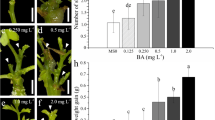Abstract
Differential regeneration response in two cotyledon types (Cot and Cot E) of Vigna radiata was reported earlier. The Cot (one cotyledon) is easily detachable from the germinating embryonal axis, whereas, Cot E (the other cotyledon) remains firmly attached during seed germination or after imbibition. Shoots differentiated directly from the Cot E under the induction of in vitro differentiation, while, under the same milieu, shoot differentiation was preceded by callus differentiation from Cot. In this study, we present comparative analyses of protein profiles from these two explant types recorded at different point of time during induction of differentiation. Cot E always contained higher amounts of soluble protein than the Cot. Likewise, higher de novo protein synthesis was noted in Cot E than in Cot as revealed by 35S methionine labeled study. Two polypeptides of ∼37 and 84 kD disappeared earlier from Cot E than Cot and is presumed to be linked with shoot induction. Two marker proteins of ∼88 and 158 kD synthesized during shoot differentiation were apparent. It was observed that the labeled protein synthesis initiated within 3h in Cot E under in vitro condition, while, no labeled protein was detected from Cot even at 12h. Irrespective of the mode of differentiation, a large amount of protein was hydrolyzed during the process of differentiation. However, in case of Cot, the process was delayed by a day than Cot E. In all probability, this is an indication of delayed cytokinin induced rejuvenation of Cot. Temporal difference in protein profile was also evident in these two explant types during in vitro differentiation. Yet, three major groups of proteins were consistently present in both the explants. The biochemical differences recorded between these two explants during induction of in vitro differentiation reflects the temporal difference in gene expression. Perhaps Cot E has the distinctiveness due to the temporal differences in certain key gene expression and proved its greater suitability over Cot for shoot regeneration purposes.
Similar content being viewed by others
Abbreviations
- BAP:
-
N6-benzylaminopurine
- Met:
-
methionine
- Cot:
-
cotyledon attached to the embryonal axis
- Cot E:
-
cotyledon firmly attached to the embryonal axis
Reference
Chandra M & Pal A, Plant Cell Rep, 15 (1995) 248.
Das S & Pal A, J Plant Biochem Biotech, 13 (2004) 101.
Ahmed F & Slinkard AE, Theor Appl Genet, 84 (1992) 688.
Gardiner SE & Forde MB, In Modern methods of plant analysis: Seed analysis Vol 14 (HF Linskens, JF Jackson, Editors) Springer-Verlag, New York (1992) pp 43–61.
Gepts P, Llaca V, Nodari RO & Panela L, In Modern methods of plant analysis: Seed analysis, Vol. 14 (HF Linskens, JF Jackson, Editors) Springer-Verlag, New York (1992) pp 63–93.
Takehisa I, Noda C, Mori S, Yamashita M, Nakanishi H, Inoue M & Kamijima O, Breeding Sci, 51 (2001) 225.
Tomooka N, Lairungreang C, Nakeeraks P, Egawa Y & Thavarasook C, Theor Appl Genet 83 (1992) 289.
Gamborg OL, Miller RA & Ojima K, Exp Cell Res, 50 (1968) 151.
Das S & Pal A, J Plant Biochem Biotech, 12 (2003) 11.
Lowry OH, Rosebrough NJ, Farr AL & Randall RJ, J Biol Chem, 193 (1951) 265.
Laemmli UK, Nature, 227 (1970) 680.
Luthe DS, Plant Physiol, 84 (1987) 337.
Sambrook J, Fritsch EF & Maniatis T, Molecular cloning: A Laboratory manual (2nd edition), Cold Spring Harbor Laboratory Press, Cold Spring Harbor, New York (1989) p E. 24.
Renaudin JP, Tournaire & de La Serva BT, Physiol Plant, 82 (1991) 48.
Maksyutova NN, Galeeva EI, Rumyantseva NI & Viktorova LV, Biology Bulletin, 32 (2005) 250.
Liu CM, Johnson S, Hedley CL & Wang TL, In Embryogenesis: The generation of a plant (TL Wang, AC Cuming, Editors) Oxford: Bios Sci. Publi, UK (1996) pp 191–213.
Beaudoin-Eagan LD & Thorpe TA, Plant Physiol, 78 (1985) 438.
Thorpe TA, Int Rev Cytol, 11A (1980) 71.
Dodeman VL & Ducreux G, Plant Sci, 120 (1996) 57.
Shan HY, Li XW, Li D, Shao XQ & Liu B, Russ J Plant Physiol, 51 (2004) 379.
Das S, Ph. D. thesis, Jadavpur University, Kolkata, India (2001) pp 22–26.
Cordewener R, Busink RJA, Traas JBM, Custers HJMD & Van Lookern Campagne MM, Planta (Berlin), 195 (1994) 50.
Racusen RH & Schiavone FM, Development, 103 (1988) 665.
Author information
Authors and Affiliations
Rights and permissions
About this article
Cite this article
Das, S., Sengupta, D.N. & Pal, A. Differential Protein Pattern of Two Cotyledon Explants of Vigna radiata During Induced In Vitro Differentiation: Probable Implication in the Conundrum of Differential Regeneration Response. J. Plant Biochem. Biotechnol. 15, 123–129 (2006). https://doi.org/10.1007/BF03321915
Published:
Issue Date:
DOI: https://doi.org/10.1007/BF03321915




